I would rate red mites as being one of the biggest problems you will face when keeping chickens. Red Mites live in the cracks of chicken houses (typically under perch ends) coming out at night, crawling onto your birds for a feed.
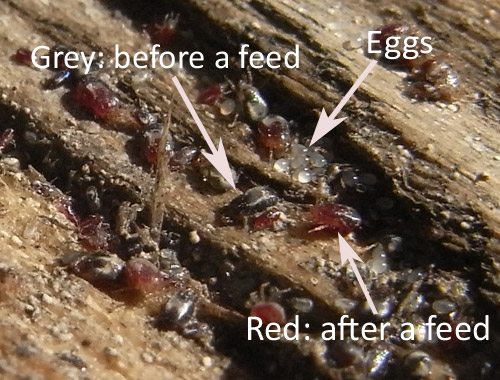
Macro shot of Red Mite in a crack on a perch. These were disturbed after a treatment with Poultry Shield.
They start off as very small greyish-white mites that swell up into red coloured mites after a feed and at their biggest are only 1mm so small numbers of them can be hard to spot unless you know what to look for.
You will often find a grey ash like deposit around perch ends which is where the mites have been and if you lift the perch, you will see clumps of mites.
Red Mite in chickens’ houses are active during the warmer months, usually May to October and will become dormant over the winter. They multiply at an incredible rate: their life cycle is just 7-10 days. In other words from hatching from an egg to being an adult laying hundreds of eggs takes just a week if conditions are right.
Be Proactive.
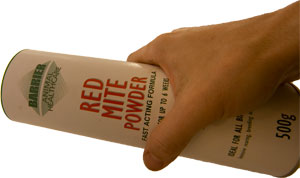 The best course of action is to check for red mite routinely when you clean your chicken house out and use some preventative treatment to the house before they get a hold. You will get to know the places to look and once you have found small numbers of them, you can treat the house to keep numbers under control. See my ‘preventative measures’ below
The best course of action is to check for red mite routinely when you clean your chicken house out and use some preventative treatment to the house before they get a hold. You will get to know the places to look and once you have found small numbers of them, you can treat the house to keep numbers under control. See my ‘preventative measures’ below
Are there Red Mite in your Chicken House?
People normally discover Red Mite when they are over-run by them. When hens are being bitten, they can refuse to go in to roost at night, they will become anaemic and their combs will go pale. They will often stop laying and you may find red blood stains on eggs (squashed Red Mites). Eventually, you will start to see losses in the flock.
Checking for Red Mite in Chickens Houses
Red Mite will hide away in the daytime but can often be seen if you lift perches, examining the ends. They will usually come swarming out if you treat the cracks with Poultry Shield but by far the easiest way to check to see if there are red mite is to take a piece of white kitchen roll and to rub it along the underside of the perch when your hens are roosting (in the dark). Look at the tissue and if there are Red Mite heading back from their feed, they will be squashed on the kitchen roll as streaks of blood.
Getting rid of Red Mite
It is very hard to get rid of them completely so it is often better to get the numbers down and then find a way of keeping them down that doesn’t involve you spending hours on cleaning the house out. There are lots of different treatments that people use, some more effective than others but I will focus on what I do and have found to be the most successful for me.
If you haven’t got red mite and the weather is warm enough for them (May to October in the UK) then skip step 1 and go straight to step 2. Preventative Measures.
1. Getting rid of an infestation.
If you find lots of red mite in the coop, it’s time for a big clean up that will take a couple of hours initially, then an hour every 5 to 7 days for at least 2 more weeks.
The products I have found to work the best (that are relatively safe) are Poultry Shield and Diatom. These two are not ‘knock down’ products as such, they do take a little while to work but are none the less very effective. I also use Red Mite Powder on the hens themselves to help them through the night when the Mites are active.
You can BUY Poultry Shield from Amazon Here.
Here is what I do with the Poultry Shield.
- Remove all birds from the house.
- Strip the house down as much as possible.
- Clean the house out – be careful where the bedding is going as red mite live for 6 months without a feed and will find a new home If they can. Ideally seal the bedding in bin bags or burn.
- Mix up as many watering cans of poultry shield mixture as is needed, as per the instructions on the label 1 part to 9 parts water.
- ‘Water’ all cracks in the chicken house, concentrating where there are perch ends and concentrations of red mite.
- Leave to soak for 15 minutes
- Red mites will be coming out. Cover them and the cracks with poultry shield again.
- Wait 15 minutes
- Hose out the house, concentrating on getting the pressure jet into the cracks and so on.
- Leave the house to dry.
Poultry Shield is a mild detergent and ‘washes’ the waxy coat off the red mites. It is also good for removing organic matter from the hen house so is useful for cleaning. I wouldn’t be without this!
After using the Poultry Shield, when the house is dry, I use Diatom. Diatom is made of micro skeletons of fossilised remains of diatoms. These were once a kind of algae found in water. They are microscopically sharp and pierce the outer waxy coating of the mites which causes them to dry out and die.
The second step also double up as my ‘preventative’ measures if you haven’t yet got a bad infestation
You can BUY Diatom from Amazon HERE
2. Preventative Measures
- Dust the ends of the perches / nest boxes and where ever else you found concentrations of red mites when cleaning.
- Rub as much into the perches as you can. Red mite will avoid the diatom and will crawl around it if they can, so make sure they have to crawl through it to get a feed.
- Repeat every couple of days for as long as you see signs of red mite in the coop.
Repeat the whole cleaning process if there are still lots of mites in 5 to 7 days. You will find you might not need to spend as long on the washing as there won’t be as many mites.
Very Important: Make sure you repeat it before 7 days so that the mites don’t have a chance to lay more eggs. A few mites become a lot in a very short space of time!
If you have a felt roof on your chicken house and they get underneath, it is usually impossible to get rid of them without removing the felt, cleaning and re-felting. My page on Chicken Houses gives more information.
Finally, I will dust the hens down between their feathers with Red Mite Powder to give them some respite during the night when the mites are active.
Beware of what you read!
There is a lot of information written about these troublesome ectoparasites on the internet these days, much of it re-written and re-spun. When I started writing about them, there was little available online. Strangely, some small errors that I had introduced on my page that I corrected in an update pop up frequently on other websites. Running a Google image search often uncovers companies that have used my copyrighted images! I make regular checks to try to stop this from happening.
If you wish to learn more about red mite then I would encourage you to read the guide to red mite on poultrykeeper.com. This is a reliable source of information and is regularly updated.

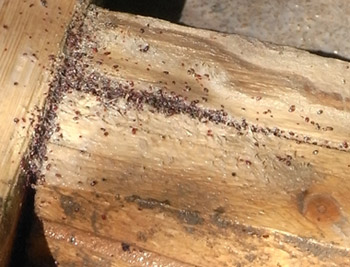

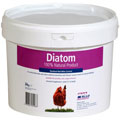

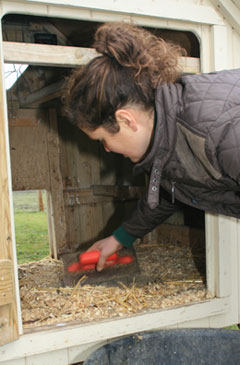
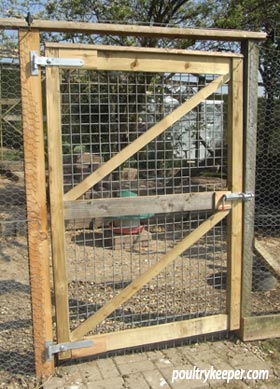
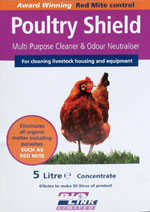
we had a problem with rats ,..all rats r gone but my rooster has no tail feathers at all an all my he
ads look like the feather has fallen from the shafts! I have sprayed clean, dusted…what could it possiably be?
He could be moulting?
Other than this, I’m not sure. Over-preening can occur when they have depluming mite but it is rare.
Hi, I am planning to get an Eglu. Are there likely to be the same infestations in a plastic coop? There seem to be far less nooks and crannies for the blight eras to hide in?! I haven’t kept chickens for a few years and the mite problem seems to have increased in my absence! I love the look of the older style wood coop but want happy hens.
Anyone have any thoughts on plastic?
Red Mites hide in cracks but can still be found in plastic coops or even under feed or water containers, anywhere that is dark and out of site. The benefit of a plastic coop is that it is far easier to strip down treat with poultry shield and then hose or pressure wash down, removing the red mite.
I am going to be testing one of each of the Omlet coops over the autumn and publishing my results on poultrykeeper.com in the winter / spring as I am interested in learning more about plastic coops myself.
I have a large red mite infestation in the chicken coop and I’m finding it difficult to follow the steps. Reasons are because I decided to have my coop in our field thus the hose cannot reach it also taking the coop apart is out of the question because it’s tied to the run with chicken wire and zipties but the main thing is is that it’s dug into the side of a 30 degrees slope. Are there any actions that I could use instead of these? Also I’m only finding the mites in the egg boxes and nowhere else although I’ve checked the coop many times before I’m only finding them in the three boxes, am I not looking hard enough or is the infestation not as bad as I think?
Hard to say really. Best thing you can do is empty and clean the house, and keep treating it every few days to kill off as many mites as you can until their numbers are under control.
Hi there, Thanks for this post, you have an incredibly interesting blog! We’re in the planning stage of getting chickens, and I am designing my coop (urban London garden so every inch counts, and building it allows much more space for the girls than freestanding). I’d like to put a green (living) roof on it, as it will insulate, help the wildlife and well, it’ll look pretty, but I’m worried that red mites will be encouraged by this… Do you think a green roof is as bad as a felt roof? Would it help if I had a clear/empty space (like an open shelf) between top of coop and the green roof? Or can I paint and seal the inside of coop with anything safe to keep them out of cracks? I suppose they can just crawl out through the vents… Basically, my question is: is a green roof a good or bad idea? Thanks, Christina V.
Oh tricky Christina, I’ve never tried a green roof before so I don’t really know. I don’t think soil or vegetation will encourage red mite but any cracks will offer them a place to hide.
If you’re vigilant checking for red mite, you should be OK.
We have a hen whose been broody for a few months now and because she’s in the coop a bit more than the others seems to quite pale around the face and wottle. We do have red mite but on top of it now, and treat more often. Try to get her out as much as possible as she forgets to feed and drink.